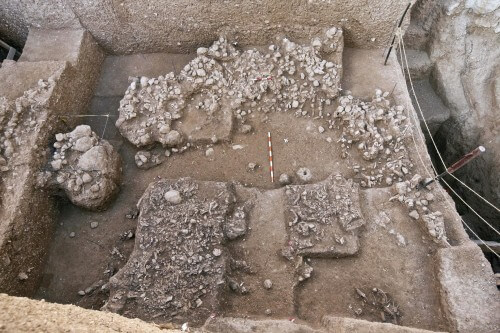This is according to an archaeological study by the University of Haifa in the open site of the oldest found in the Middle East region from the Middle Palaeolithic period*

Wild ox, horses, donkeys and even rhinoceros - all of these were part of the diet of our ancient ancestors, who lived in the Ramla region about 170 thousand years ago, according to an archaeological study by the University of Haifa at the Hector site (open site), one of the earliest found in the Middle East from the Middle Palaeolithic period . This is what Dr. Yossi Zeidner presented today (Sunday) at the annual conference of the Zinman Institute for Archeology of the University of Haifa.
Several years ago, during the mining operation of the Nesher Quarry near Ramla, the prehistoric site was discovered and a rescue excavation, led by Dr. Zeidner from the Zinman Institute of Archaeology, took place during the years 2010-2011.
From the research recently published in the journal JOURNAL OF HUMAN EVOLUTION, it becomes clear that this is the site of the members of the Mousterian culture, a hunter-gatherer culture, from the Middle Paleolithic period (from about 250 thousand to about 40 thousand years before our time). The site was discovered in a karst depression created due to the collapse of the surface in karstic cavities that are tens of meters below the surface in layers of limestone from the Bina Formation. The depth of the depression is 34 meters and during the last tens of thousands of years it was filled with soil that was washed away from the slopes of the nearby hills. It seems that during the filling, periods of time in which the soil erosion activity was intense alternated with relatively stable periods, in which the filling rates were slow and allowed hominids to use the depression.
According to Dr. Zeidner, from our knowledge of the Mousterian culture in the Middle East, it seems that this is the first time that the remains of this culture have been discovered in such an unusual context. For the most part, the members of the Mousterian culture lived in caves, which served them as base camps where stone tools, body parts of hunted animals and other resources were brought. Also, a small number of small sites with few finds were discovered that were used as short-term parking sites or hunting sites and were discovered on the banks of streams and lakes.
The unique site contained many surprises. Already during the excavation, researchers discovered animal bones, such as extinct species of wild ox, horse and even rhinoceros. Along with the animals of these body sizes, bones of small animals were also discovered, among them an Eretz Israel deer and a land deer. "The large amount of bones we found in such a small area matched very well the patterns we knew from the cave dwellers. However, mostly small animals were discovered in the caves. The bones of the large animals actually matched the patterns of the open sites, but there the quantity was usually much smaller. It seems that we have found a site that combines both the characteristics of caves and temporary camps," said Dr. Zidner. In light of the fact that the researchers also found cutting marks with sharp tools, the assumption is that the site was a hunting site, or a meeting place after the hunting, where the hunted animals were slaughtered. "The fact that evidence of exposure to fire was found on some of the bones indicates that the site was probably also used as a feasting place," he added.
Another feature that supported this assumption was the lack of diversity in the stone tools found. While a wide variety of tools were found in the caves, at the present site the variety of tools found was limited and consisted mainly of scrubbers.
According to the difference in the richness of the findings at the different levels of the site, the researchers estimate that the meeting site near Ramla was inhabited mainly about 170 thousand years ago and it remained a central meeting place until 130 thousand years ago. Since then the activity in it decreased until it became almost non-existent around 100 thousand years before our era.
"The archaeological remains show many changes in the way the site was used over this long period of time. It seems that during the accumulation of the lower layers, the use of the site was very intense. In these layers, evidence of many hearths and dense levels of activity, rich in flint tools and waste from their preparation, animal remains and pebbles that were apparently used as maces and anvils, were revealed. The animal bones in these layers underwent intensive human treatment until they were broken to extract bone marrow. The find from the upper layers shows a different settlement model characterized by a low density of finds, the absence of hearths, changes in the composition of the stone tool set and a different model of the utilization of the bones, most of which remained intact. It seems that this period of time in the history of the site was characterized by temporary and short visits", concluded Dr. Zeidner.

7 תגובות
Native Americans smoked it with buffalo
Yair
170000 years …. Not exactly Jews 🙂
It seems to be Neanderthals. Homo sapiens appeared at the earliest 150,000 years ago and left Africa for the Land of Israel about 100,000 years ago (the first departure). The Neanderthals used Musterian stone tool technology until they became extinct.
Miracles, read what they ate and how they spent their Saturdays in evolution
Yair
How does this prove it?
Which proves that our ancestors were secular
Since it is difficult to drag a large hunter like Prim, is it possible that the pit was used as a trap? The animals were smuggled to the steep edge of the pit, fell and then slaughtered?